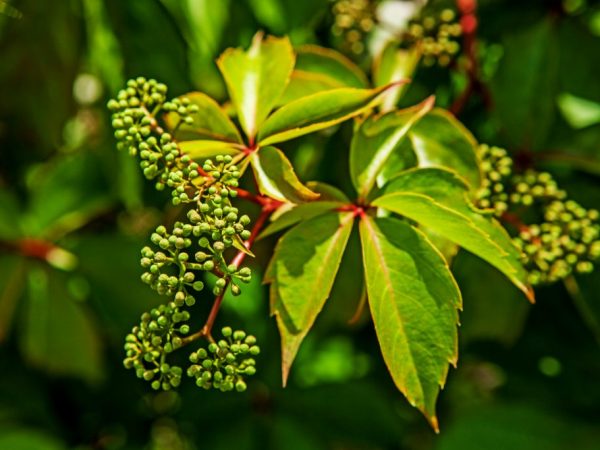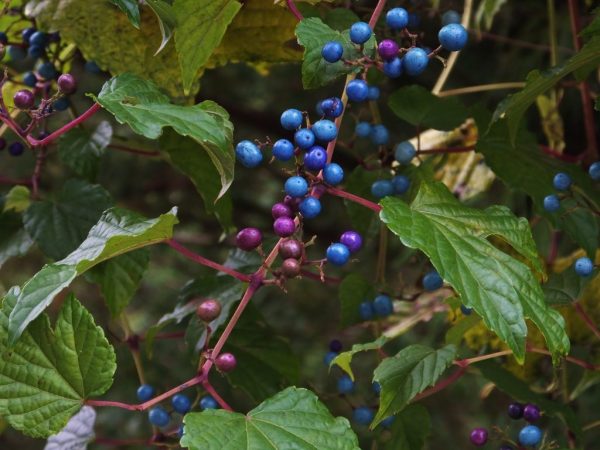Aconitol vineyard
The vineyard is an ornamental plant that looks like ivy, but produces fruit similar to grapes. This is a vine-like culture that winds up walls and can create hedges. There is an aconitol vineyard, a short-stemmed and Ussuri vineyard.

Aconitol vineyard
What is this plant
The common name for these plants is Ampelopsis. The variety includes about 20 species, among them grape-leaved. These are climbing vines with a height of 2 to 8 m. They come from America and the East, but now they are cultivated all over the world. In America it is considered a weed.
The variegated vineyard prefers a warm climate and protected areas for growth. It is used for decorative purposes: a hedge is made out for it, it is used as a culture for gardens and gazebos.
In the form of lianas, the grape plant practically does not require pruning (unless to correct growth). It bears fruit with beautiful grape-like fruits. They differ in that they are not decorated in such dense bunches, but inside there is a white pulp. The fruits of the plant are not edible!
In Russia, the short-stemmed vineyard or the Ussuri vineyard, ampelopsis aconitolous, is chosen. They have the best survival rates in temperate climates. The average lifespan of the species is from 5 to 10 years.
Vineyard short-stemmed (Ussuriysky)
This species is most similar to a true vine. Description of the plant:
- red thin shoots;
- sheet, dissected into 3 or 5 blades;
- foliage is similar to grape, rough, wrinkled;
- the color of the berries is from turquoise to purple.
Previously, the Ussuri species was considered a variety of a variegated plant. But the species differ from each other in the dissection of leaves and color (in variegated foliage of a uniform green color and more carved).
The temperature for a plant should not fall below 18 ° C in summer, and below 2 ° C in winter. It blooms in June or July for 60 days.
Aconite-leaved species
Under natural conditions, the Aconitolist species grows in moist soil in the valleys. In the first years of life, growth is slowed down, then accelerates. Plant characteristics:
- height - up to 4 m;
- young leaves have a bright purple color;
- adult shoots become blue-gray;
- ripe fruits are blue.
Liana is used for small plantings, decorating gazebos and small green hedges. Initially, the variety was distributed in the North-East of China, but now it is cultivated in Russia.
Features of planting and care

The plant needs good care
An ornamental plant needs care, as well as a fruiting one. The main stages of caring for grapes are planting, transplanting, choosing a place (for open areas), pruning, reproduction, watering.
Planting in soil
When planting in a container or pot, prepare the soil containing:
- equal parts of garden and greenhouse land, sand;
- manure;
- composted seaweed.
It is recommended to feed the vineyard since April.Use mixtures for indoor plants. For open soil, all types of fertilizers suitable for the vine will do.
Transfer
The pot culture is transplanted every 2-3 years. In the case of planting in open ground, the care of the plant remains the same. It tolerates wintering well if the vine is protected.
The culture in pots for the winter is removed to the cellar or brought into the room. It is undesirable to transplant the plant in the open field.
Plot and pruning
They should be planted with vine leaves in darkened areas. In the sun, the leaves dry out and lose color.
Cropping the crop is not required. It is carried out only if it is necessary to form a bush or direct the growth of a vine. Indoor plants are also pruned to stimulate growth.
Reproduction of culture
Ampelopsis is propagated through seeds (in fruits) or cuttings. Features of the ways:
- Seeds are extracted from the fruits, dried. The germination rate of the planting material is high even when planted in open ground. The seed plant will begin to bear fruit only after 10 years. Stored up to 4 years.
- A stalk with an inter-nodal bud is taken from an adult bush. Rooting rate ranges from 80-85%. Such shoots bloom faster and bear fruit.
Pests and infections
The plant is sprayed regularly (1-2 times a week) against pests and infections. They are often affected by powdery mildew and mildew. Ailments are manifested by yellow spots on the leaves. The spots turn brown over time, the leaves fall off.
The causes of the appearance of diseases:
- high humidity;
- lack of trace elements and nutrients in the soil;
- infection from another culture.
The spotted mosaic is incurable, so the affected plants are destroyed. It is also worth keeping an eye on crops that have a similar list of pests.
Conclusion
Culture is a decorative decoration of the site and a hedge. The plant is non-aggressive, so it will not kill other shoots. The species is similar to grapes, but its fruits are inedible. For a temperate climate, a short-flowered or aconitolous species is chosen.
They are grown on a plot or at home in pots. Plant care consists in pruning, protection from diseases, watering, transplanting. There are two ways to propagate a culture: by seeds and cuttings.

